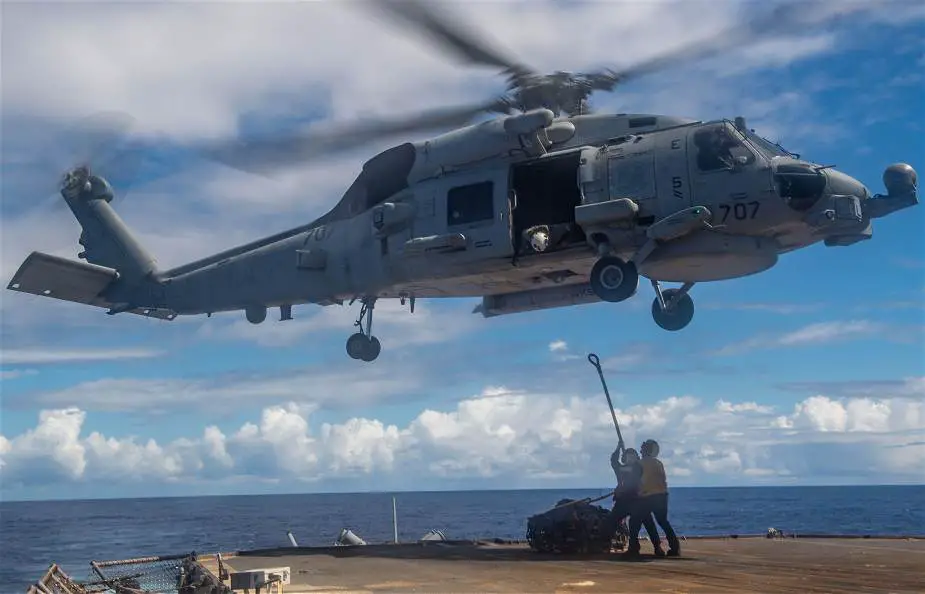Breaking news
Euronaval Online 2020: Lockheed Martin displays MH-60R SeaHawk world's most advanced maritime helicopter.
At Euronaval Online, the digital edition of Euronaval 2020, the International naval defense and maritime security industry exhibition, American company Lockheed Martin displays on its virtual booth the MH-60R Seahawk, the world's most advanced maritime helicopter.
 U.S. sailors assigned to the flight deck crew aboard the Ticonderoga-class guided-missile cruiser USS Antietam (CG 54) hook up a mock cargo load for a vertical replenishment with an MH-60R Sea Hawk, assigned to the "Saberhawks" of Helicopter Maritime Strike Squadron (HSM) 77. (Picture source U.S. Navy)
U.S. sailors assigned to the flight deck crew aboard the Ticonderoga-class guided-missile cruiser USS Antietam (CG 54) hook up a mock cargo load for a vertical replenishment with an MH-60R Sea Hawk, assigned to the "Saberhawks" of Helicopter Maritime Strike Squadron (HSM) 77. (Picture source U.S. Navy)
Operational and deployed today with the U.S. Navy as the primary anti-submarine warfare anti-surface weapon system for open ocean and littoral zones, the MH-60R SEAHAWK® helicopter is the world’s most advanced maritime helicopter. It is the most capable naval helicopter available today designed to operate from frigates, destroyers, cruisers, and aircraft carriers.
The MH-60R is known as “the world’s most advanced maritime helicopter with more than 300 of them operating worldwide. In February 2020, India became the latest country to add 24 MH-60Rs to its fleet. They join fellow navies from the United States, Denmark, Australia, and Saudi Arabia.
The Sikorsky MH-60 Seahawk is a twin turboshaft engine, multi-mission helicopter based on the UH-60 Black Hawk and a member of the Sikorsky S-70 family. The most significant modifications are the folding main rotor and a hinged tail to reduce its footprint aboard ships.
The MH-60 is used by naval forces in two configurations including the MH-60R and the MH-60S. The MH-60 can be deployed aboard any air-capable frigate, destroyer, cruiser, fast combat support ship, amphibious assault ship, Littoral combat ship, or aircraft carrier. It can conduct anti-submarine warfare (ASW), anti-surface warfare (ASuW), search-and-rescue (SAR), naval gunfire support (NGFS), surveillance, communications relay, logistics support and personnel transfer, and vertical replenishment (VERTREP) missions.
The avionics of MH-60R includes dual controls and instead of the complex array of dials and gauges in Bravo and Foxtrot aircraft, 4 fully integrated 8" x 10" night vision goggle-compatible and sunlight-readable color multi-function displays, all part of glass cockpit produced by Owego Helo Systems division of Lockheed Martin.
Onboard sensors include: AN/AAR-47 Missile Approach Warning System by ATK,[18]Raytheon AN/AAS-44 electro-optical system that integrates FLIR and laser rangefinder, AN/ALE-39 decoy dispenser and AN/ALQ-144 infrared jammer by BAE Systems, AN/ALQ-210 electronic support measures system by Lockheed Martin, AN/APS-147 multi-mode radar/IFF interrogator, which during a mid-life technology insertion project is subsequently replaced by AN/APS-153 Multi-Mode Radar with Automatic Radar Periscope Detection and Discrimination (ARPDD) capability, and both radars were developed by Telephonics, a more advanced AN/AQS-22 advanced airborne low-frequency sonar (ALFS) jointly developed by Raytheon & Thales, AN/ARC-210 voice radio by Rockwell Collins, an advanced airborne fleet data link AN/SRQ-4 Hawklink with radio terminal set AN/ARQ-59 radio terminal, both by L3Harris, and LN-100G dual-embedded global positioning system and inertial navigation system by Northrop Grumman Litton division.
The MH-60R can be armed can be equipped with a range of weapons on the four weapons stations, including Lockheed Martin AGM-114 Hellfire anti-surface missiles. For anti-submarine warfare, the MH-60R can carry up to three ATK mk50 or mk46 active/passive lightweight torpedoes. The side of the helicopter can be fitted with a pintle-mounted weapon station armed with a 7.62mm machine gun.
The MH-60R is powered by two General Electric T700-GE-401C turboshaft engines rated at 1,425kW. It can fly at a maximum speed of 267 km/h with a maximum cruising range of 834 km.

























